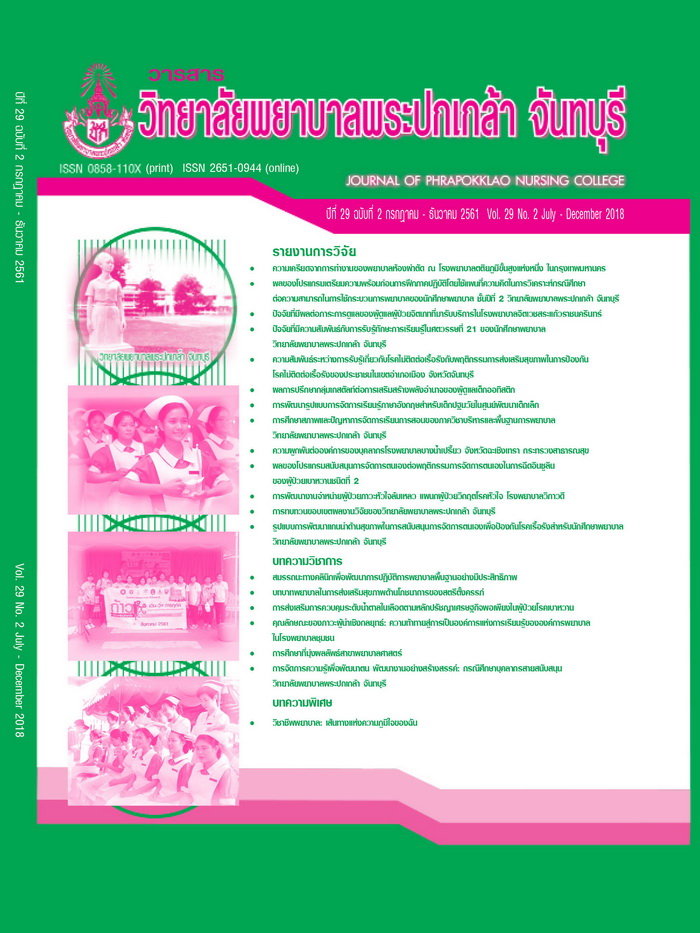Development Model of English Learning Management for Preschool Children in Child Care Center
Keywords:
Preschool children, Child care center, Learning management, EnglishAbstract
This research and development aimed to develop a model of English learning management for preschool children in child care center and to examine its effectiveness. The research procedure consisted of 4 phases: 1) analyzing based line data of child care center; 2) developing the model; 3) testing the developed model; and 4) extending the model using. The samples for testing the developed model consisted of 30 pairs of parents and 2-4 year children receiving services at the child care center of Phrapokklao Nursing College, Chanthaburi. The research instruments were composed of an activity of “AEC for kids”, a model of “2 teachers and parent”, an activity of “cooperative learning for promoting language development”, the questionnaires with the reliabilities in the range of .86-.93, and an assessment form. The implementation and data collection were conducted from May to November, 2017. Data were analyzed using frequency, percentage, mean, standard deviation, paired t-test, and content analysis.
The research results revealed that 1) the model of English learning management for preschool children in child care center was “2 teachers and parent” or “2TP Cooperative Learning Model” that comprised Teacher1: the class teacher who taught English such as for easy words for everyday use, English songs for kids; Teacher2: the English native speaker who taught at least 1 hour a week; and Parent who told fairy tale with their children at least 10 minutes per time and 3 times a week; and 2) the effectiveness of the model, it was found that after the implementation of an activity of “AEC for kids”, and an activity of “let read bilingual fairy tale”, the parent had statistically significant higher mean scores of opinion regarding English skill than before the implementation (t = 3.210, p < .001 and t = 7.160, p < .001, respectively). Additionally, after the implementation of an activity of “cooperative learning for promoting language development”, the parent had mean score of opinion at a good and a very good level.
This research suggests that other child care centers should apply this model for promoting English skill learning of preschool children based on the appropriate situations and contexts in order to enhance language development among these children.
References
กระทรวงสาธารณสุข. (2556). คู่มือเฝ้าระวังและส่งเสริมพัฒนาการเด็กปฐมวัย Developmental Surveillance and Promotion Manual (DSPM). นนทบุรี: ผู้แต่ง.
เกรียงศักดิ์ สยะนานนท์, และวัฒนา พัดเกตุ. (ม.ป.ป.). อายุกับการเรียนภาษาอังกฤษ และปัจจัยที่มีอิทธิพลต่อความพอใจหรือไม่พอใจในการเรียนภาษาอังกฤษ. สืบค้นจาก http://www.human.nu.ac.th/jhnu/file/journal/2011_02_01_11_01_47-02-02-02.pdf
ณัฐวดี ศิลากรณ์. (2556). ความสามารถทางการพูดของเด็กปฐมวัยที่ได้รับการจัดกิจกรรมเล่านิทานประกอบหุ่น (ปริญญานิพนธ์ปริญญามหาบัณฑิต). กรุงเทพฯ: มหาวิทยาลัยศรีนครินทรวิโรฒ.
นิตยา คชภักดี. (2543). ขั้นตอนการพัฒนาของเด็กปฐมวัยตั้งแต่ปฏิสนธิ-5 ปี. กรุงเทพฯ: โรงพิมพ์คุรุสภาลาดพร้าว.
ยุทธนา มิ่งเมือง. (2549). การบริหารจัดการศูนย์พัฒนาเด็กเล็กเทศบาลเมืองคูคต จังหวัดปทุมธานี (สารนิพนธ์ปริญญามหาบัณฑิต). นครปฐม: มหาวิทยาลัยศิลปากร. สืบค้นจาก http://www.thapra.lib.su.ac.th/objects/thesis/fulltext/snamcn/Yuthana_Mingmuang/Fulltext.pdf
ราตรี อิงมั่น. (2556). ความพึงพอใจของผู้ปกครองที่มีต่อการจัดการศึกษาปฐมวัยของโรงเรียนพันธะวัฒนา กรุงเทพมหานคร (วิทยานิพนธ์ปริญญามหาบัณฑิต). กรุงเทพฯ: มหาวิทยาลัยมหาจุฬาลงกรณราชวิทยาลัย. สืบค้นจาก http://www.mcu.ac.th/userfiles/file/thesis/Educational-Administration/56-2-11-047.pdf
สมเกียรติ อ่อนวิมล. (2555). การใช้ภาษาอังกฤษและภาษาอื่นในภูมิภาคกับอนาคตของไทยในอาเซียน. สืบค้นจาก http://www.dla.go.th/upload/ebook
สราวดี เพ็งศรีโคตร, และจันทร์ชลี มาพุทธ. (2554). รูปแบบการมีส่วนร่วมของผู้ปกครองในการจัดการศึกษาปฐมวัย. วารสารการศึกษาและพัฒนาสังคม, 7(1), 68-82.
สุภาภรณ์ ดำดี. (2555). ผลของโปรแกรมส่งเสริมการเล่านิทานต่อพฤติกรรมเล่านิทานและความพึงพอใจต่อโปรแกรมในมารดาของเด็กวัยก่อนเรียนที่เข้ารับการรักษาในโรงพยาบาล (วิทยานิพนธ์ปริญญามหาบัณฑิต). กรุงเทพฯ: มหาวิทยาลัยมหิดล.
อดุลย์ วังศรีคูณ. (2557). การศึกษาไทยในศตวรรษที่ 21: ผลผลิตและแนวทางการพัฒนา. วารสารมนุษยศาสตร์และสังคมศาสตร์ บัณฑิตวิทยาลัย มหาวิทยาลัยราชภัฏพิบูลสงคราม, 8(1), 1-17.
อารีย์ คำสังฆะ. (2554). การส่งเสริมความเข้าใจภาษาของเด็กปฐมวัยโดยผู้ปกครองใช้ชุดกิจกรรม “เล่นกับลูกปลูกภาษา” (ปริญญานิพนธ์ปริญญามหาบัณฑิต). กรุงเทพฯ: มหาวิทยาลัยศรีนครินทรวิโรฒ.
Epstein, J. L., Sanders, M. G., Simon, B. S., Salinas, K. C., Jansorn, N. R., & Van Voorhis, F. L. (2002). School, family, and community partnerships: Your handbook for action (2nd ed.). Thousand Oaks, CA: Corwin Press. Retrieved from https://www.govinfo.gov/content/pkg/ERIC-ED467082/pdf/ERIC-ED467082.pdf
Gardner, H. (2011). Howard Gardner’s Theory of Multiple Intelligences. Retrieved from https://www.niu.edu/facdev/_pdf/guide/learning/howard_gardner_theory_multiple_intelligences.pdf
Kaushanskaya, M., Gross, M., Sheena, E., & Roman, R. (2017). Novel morpheme learning in monolingual and bilingual children. American Journal of Speech-Language Pathology, 26(2), 301-315.
Downloads
Published
How to Cite
Issue
Section
License
Copyright (c) 2018 JOURNAL OF PHRAPOKKLAO NURSING COLLEGE

This work is licensed under a Creative Commons Attribution-NonCommercial-NoDerivatives 4.0 International License.
เนื้อความ ข้อมูล และรายการอ้างอิงที่ผู้เขียนใช้ในการเขียนบทความเพื่อลงตีพิมพ์ในวารสารวิทยาลัยพยาบาลพระปกเกล้า จันทบุรี ถือเป็นความคิดเห็นและความรับผิดชอบของผู้เขียน คณะผู้จัดทำวารสารไม่จำเป็นต้องเห็นพ้องด้วยหรือร่วมรับผิดชอบ
บทความที่ได้รับการลงตีพิมพ์ในวารสารวิทยาลัยพยาบาลพระปกเกล้า จันทบุรี ถือเป็นลิขสิทธิ์ของวารสารวิทยาลัยพยาบาลพระปกเกล้า จันทบุรี หากหน่วยงานหรือบุคคลใดต้องการนำส่วนหนึ่งหรือทั้งหมดของบทความไปเผยแพร่ต่อเพื่อวัตถุประสงค์ใด ๆ จะต้องได้รับอนุญาตจากบรรณาธิการวารสารก่อน



